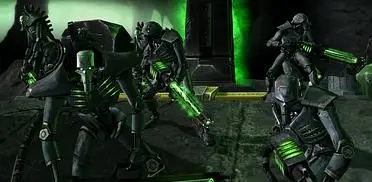Aliens: Fireteam Elite taps into the cathartic joy of blasting apart entire swarms of Xenomorphs with a varied arsenal of high-powered guns. It’s not hard to get a sense of whether or not you’re on board with what it has to offer, since it never beats around the bush.
There’s enough story to give your efforts a direction, in between bouts of intense action, but the focus falls very much on pointing your gun at the enemy and firing away while staying alive.
The terrifying, lethal Xenomorph spawned from H.R. Giger’s imagination left its mark on popular culture as a horror antagonist but, as developer Cold Iron Studios has proven, it slots quite well into an action context.
Game Premise
Aliens: Fireteam Elite is a third-person co-op shooter in the vein of Left 4 Dead that sees your team of three facing an onslaught of Xenomorphs and synths, on and around the planed LV-895, while spicing things up by introducing classes and customizable weaponry to the mix.
Single-player Campaign
You can put your shooting skills to the test across four campaigns linked by a common narrative thread as well as an extra horde mode. Each campaign is made up of three missions (20-30 minutes per piece) and can be tackled on your own, alongside two AI synth companions named Alpha and Beta. They’re mostly reliable, dispatching foes, reviving you and each other, or healing up when needed, but they tend to struggle against the bigger Xenos.
Even on Standard difficulty – the second of five –, they’ll have trouble freeing each other when pinned down and sometimes watch passively as attackers hack away at you. Although they are equipped with the same loadout as the Gunner class, they’re less efficient than a full human squad, but will see you through Standard difficulty.
The story won’t make you shed a tear; but the effort put into giving your actions a purpose, as well as the additional Intel you can find in levels, providing broader context on what’s happening in the universe, help create a surprisingly believable environment around your mission.
Multiplayer
The multiplayer mode is essentially the single-player campaign but played alongside human teammates. It draws from the same pool of maps and yields similar rewards. Replacing the AI with (hopefully) fleshier pals make for better communication lets you use the abilities and guns of three classes instead of just your own, which makes a significant difference.
Starting with Intense difficulty, coordinating ability use plays an increasingly important role, especially when defending fixed positions and the swarm throws all it has your way. It’s always great to see your team coordinating fire rate buffs, with ammo replenishing stations and drones that reduce enemy damage, or even three Technician turrets mowing down Xenomorphs in unison.
What’s less great is the omission of voice and text chat, which basically means you have to rely on a rudimentary ping system to communicate your plans. Add an increasing amount of friendly fire and you’ll want to go in as a team of three, rather than rely on random players and hope that everyone is as knowledgeable and has the same idea about handling the incoming threat.
Having individual matchmaking for each available level is a plus, in terms of choice. But once you add five difficulties and the option to toggle challenge cards on or off, you end up with split queues that can see you waiting for tens of minutes before you find a match with your desired settings, even at peak hours.
Gameplay Mechanics
Aliens: Fireteam Elite’s approach to third-person co-op action is fairly straightforward. As a team of three, you make your way through the interiors of ships, space stations, and ancient ruins while culling Xenomorphs and other nasty things that want you dead. Its linear levels also include collectibles like intel, which expands upon the lore, and hidden caches, which grant extra rewards in the shape of attachments, weapons, and skins.
Missions alternate between portions during which you defend fixed positions and those in which you move and shoot, but not without giving you brief moments to catch your breath. When you’re dealing with more difficult waves – often waiting for your trusty AI friend to complete a mission-critical task –, you’re always given an ammo box and medkit to replenish, as well as various consumable items like turrets, drones that increase your damage, or incendiary ammo. On Standard difficulty, these are spaced out so you don’t always feel like a god of death with an infinite stockpile of ammo in your pocket. On Intense (and above), you’ll miss them considerably more.
The campaign also has a couple of surprises in store for you when you first run it, but upon replaying, you will already know when it’s best to push through, which chest-high wall to use for cover, and even get a good sense of what enemies you might expect. The swarm repeatedly tests your ability to shoot many things really well, but the bigger opponents aren’t as interesting as they could be.
Don’t get us wrong, the moment a Praetorian first waltzes up to you, you’re in full panic mode, unloading everything you have into it. But after a fight or two, you realize that your tactics don’t change all that much and these evolved Xenomorphs – whether they spit acid balls from afar, or retreat into conveniently placed holes after pinning you down –, are rather predictable. Their main strength comes from being bullet sponges and having 15 other friends trying to nibble at your toes.
You tackle these missions as one of four classes: Gunner, Demolisher, Technician, and Doc. The fifth, Recon, is unlocked once you beat all four campaigns while a sixth, Phalanx, arrives alongside the first season of free content, on September 8. Where the Gunner is a medium-to-long-range expert that can boost the team’s fire rate and reload speed but also lob grenades, the Demolisher can equip heavy weapons like the Smartgun and fire mini-rockets from a shoulder-mounted launcher.
The Technician carries a deployable turret, while the Doc’s trauma station provides on-the-go healing on top of the medkits that everyone carries with them. Each one is a viable pick with a different playstyle but we found it hard to let go of the Smartgun and its impressive room-clearing capabilities.
Weapon loadouts and perks further differentiate between classes. The latter sees you playing upgrade Tetris, as they’re placed on a grid. You can get flat bonuses for your weapon skills from core perks, and link modifiers to the skills around the edges to either make them more effective or alter how they behave. Portions of the grid are locked behind certain class levels, and you’ll need to play beyond completing the campaign once to unlock everything. On top of that, weapons also level up, receiving up to four permanent bonuses the more you use them.
There’s enough personality to each class that you will want to try out all of them, as well as the guns rewarded at the end of successful missions or purchased from the armory on the Endeavor, your home ship. In fact, they are the main reason to replay levels, given how good they feel in your hands. You can also upgrade them using various attachments, some of which add a subtle gameplay element, like a stacking buff or leaving behind a pool of fire under certain conditions.
Aliens: Fireteam Elite does use a Combat Rating system to indicate your character’s relative strength, but doesn’t have you perpetually chasing incremental upgrades, at least at the moment. All weapons have their own combat rating that you can increase using attachments. Your modifications and weapon level join them to improve your character’s overall rating. If you’re feeling adventurous, you can also gain extra rewards by applying challenge cards to a mission, for added difficulty.
Visuals
Aliens: Fireteam Elite’s interiors really capture the impressive art style of the more recent movies in the franchise. Dark, narrow hallways lead into open rooms that do leave you awestruck. Good use of shadows does create an atmosphere of mystery – even when you’re knee-deep in the blood of a hundred Xenomorphs – while the explosions of red barrels or mines really make for powerful contrasts, instantly drawing attention towards them.
The exterior areas don’t hit the mark as much, but there are only a few of them. The choice to not have characters’ mouths animated when they talk, however, is rather jarring.
Audio & Music
Fireteam’s guns are the stars of the show and their sound plays heavily into what makes them so great. Not only does the game do its Pulse Rifle justice, but most weapons have an adequate punch, including the smaller firearms that you shouldn’t underestimate. The Smartgun’s loud roar does deserve a special mention, but you’ll find that weapons in the same class feel distinct from one another, aside from simply being a joy to use.
Fireteam’s music supports its action, but may not be a soundtrack you keep on repeat after you’re done with your slaughter session. In its more peaceful moments, you’ll find it pleasingly adventurous, while the combat music does amplify the tension of seeing tens of Xenos or synths making their way towards you. The screeches of special Xenomorphs are, however, not all that easy to recognize.
AI
The enemy AI isn’t particularly bright but does pose a significant threat – depending on difficulty – and can make your life hard through sheer numeric advantage. While it may get stuck navigating ceilings and bits of terrain, we did, on quite a few occasions, get out of fights by the skin of our teeth.
There’s, nonetheless, some other odd behavior. Prowlers often wait in plain view, like the goofy sidekick of a cartoon villain, and even the Warrior – dangerous as it is – casually walks around, takes its time to remind you that it’s imposing, and has a drawn-out special attack. This gives you a fighting chance, but it doesn’t blend too well with the rest of the action.
Accessibility
Aliens: Fireteam Elite comes with four colorblind mode settings, as well as adjustable strength. Other accessibility features, as per the screenshot above, include Menu Parallax, switching the aim down sights mode from Hold to Toggle, alongside subtitle options.
Performance
On an Intel i7-8700K, 16 GB Ram, and Nvidia 1070 GTX @ 1080p, we did see our share of frame drops on the highest settings, but only when looking at certain parts of levels from certain angles. Certain more crowded fights (but not all of them) did also suffer from visibly reduced smoothness. Changing the shadow setting to Medium and Antialiasing to 2 did see some improvement in exchange for minimal quality loss.
TOP GAME MOMENT
Mowing down the last Xenomorphs in a swarm using the Smartgun and barely making it out alive to the nearby extraction point.
ALIENS: FIRETEAM ELITE VERDICT
Aliens: Fireteam Elite is an unapologetically loud action movie in video game form. It wants you to kill lots of things and it gives you plenty of tools to do so. While its special enemies are a bit of a letdown, the weapon sounds and overall pacing of combat encounters compensate for it. The structure of these encounters can get a bit formulaic and does gradually lose its charm the more you play through the same level, but intense battles and narrative surprises make for a fun first playthrough, while maxing out every class and trying all the available guns contribute towards potential replayability.
It may not have the longevity of some of its counterparts, with levels getting a little too familiar a little too soon and the AI never being particularly clever. The glaring omission of voice and text chat is also a head-scratcher, which is why you’ll ideally want to go in with a full squad of three to make the most out of the game’s classes.
At the end of the day, Aliens: Fireteam Elite doesn’t reinvent the wheel, but it’s a game that clearly knows what it wants to be. It’s not the most sophisticated co-op shooter out there and won’t exactly blow your mind with its uniqueness, but if you want to spend an evening shooting up Xenomorphs alongside friends, it has you covered.
Good vs Bad
- Weapons sound and feel great
- Intense battles
- Art style captures the essence of the franchise
- Straightforward approach to co-op, if you dig that
- Difficulties that accommodate both casual and hardcore players
- Lack of voice/text chat
- Levels get repetitive a little too soon
- Disappointing special enemies
- May not have the replayability of some of its peers











.webp)

